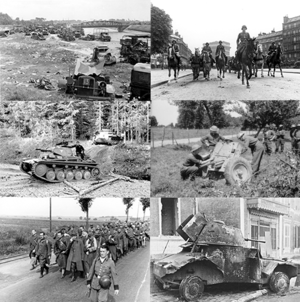| Battle of France | |||||||||
|---|---|---|---|---|---|---|---|---|---|
| Part of the Western Front of the Second World War | |||||||||
 Clockwise from top left: | |||||||||
| |||||||||
| Belligerents | |||||||||
|
| |||||||||
| Commanders and leaders | |||||||||
| Units involved | |||||||||
|
Axis armies
|
Allied armies | ||||||||
| Strength | |||||||||
|
Germany: 141 divisions 7,378 guns[2] 2,445 tanks[2] 5,638 aircraft[3][c] 3,300,000 troops[4] Italians in the Alps 22 divisions 3,000 guns 300,000 troops Total: 3,600,000 troops |
Allies: 135 divisions 13,974 guns 3,383–4,071 French tanks[2][5] <2,935 aircraft[3][d] 3,300,000 troops French in the Alps 5 divisions ~150,000 troops Total: 3,450,000 troops | ||||||||
| Casualties and losses | |||||||||
|
Germany: Total: 162,587 |
73,000 killed 240,000 wounded 15,000 missing[g] 1,756,000 captured 2,233 aircraft lost[24] 1,749 French tanks lost[h] 689 British tanks lost[i] | ||||||||
The Battle of France (French: bataille de France; 10 May – 25 June 1940), also known as the Western Campaign (German: Westfeldzug), the French Campaign (Frankreichfeldzug, campagne de France) and the Fall of France, during the Second World War was the German invasion of the Low Countries (Belgium, Luxembourg and the Netherlands) and France. The invasion plan for the Low Countries and France was called Case Yellow (German, Fall Gelb). Fall Rot (Case Red) was planned to finish off the French and British after the evacuation at Dunkirk. The Low Countries and France were defeated and occupied by Axis troops down to the Demarcation line, ending land operations on the Western Front until the Normandy landings on 6 June 1944.
On 3 September 1939, France and Britain declared war on Germany, over the German invasion of Poland on 1 September. In early September 1939, France began the limited Saar Offensive but by mid-October had withdrawn to their start lines. German armies invaded Belgium, Luxembourg, the Netherlands, and France on 10 May 1940.
In Fall Gelb ("Case Yellow"), German armoured units made a surprise push through the Ardennes and then along the Somme valley, cutting off and surrounding the Allied units that had advanced into Belgium to meet the German armies there. British, Belgian and French forces were pushed back to the sea by the Germans where the British and French navies evacuated the encircled elements of the British Expeditionary Force (BEF) and the French and Belgian armies from Dunkirk in Operation Dynamo.
German forces began Fall Rot ("Case Red") on 5 June 1940. The remaining Allied divisions in France, sixty French and two British, made a determined stand on the Somme and Aisne rivers but were defeated by the German combination of air superiority and armoured mobility. Italy entered the war on the German side on 10 June 1940 and began the Italian invasion of France. German armies outflanked the Maginot Line and pushed deep into France, occupying Paris unopposed on 14 June. After the flight of the French government and the collapse of the French Army, German commanders met with French officials on 18 June to negotiate an end to hostilities.
On 22 June 1940, the Second Armistice at Compiègne was signed by France and Germany. The neutral Vichy government led by Marshal Philippe Pétain replaced the Third Republic and German military occupation began along the French North Sea and Atlantic coasts and their hinterlands. The Italian invasion of France over the Alps took a small amount of ground and after the armistice, Italy occupied a small area in the south-east. The Vichy regime retained the zone libre (free zone) in the south. Following the Allied invasion of French North Africa in November 1942, in Case Anton, the Germans and Italians took control of the zone until France was liberated by the Allies in 1944.
- ^ a b c d e f Scheck 2010, p. 426.
- ^ a b c Umbreit 2015, p. 279.
- ^ a b c d Hooton 2007, pp. 47–48.
- ^ Publishing, D. K. (1 October 2009). War: The Definitive Visual History. Penguin. p. 467. ISBN 978-0-7566-6817-4. Retrieved 14 June 2024.
- ^ a b Zaloga 2011, p. 73.
- ^ a b c Frieser 1995, p. 400.
- ^ Cite error: The named reference
Autopsie d p. 59was invoked but never defined (see the help page). - ^ Sheppard 1990, p. 88.
- ^ Hooton 2010, p. 73.
- ^ Murray 1983, p. 40.
- ^ Healy 2007, p. 85.
- ^ Zaloga 2011, p. 76.
- ^ Sica 2012, p. 374.
- ^ Porch 2004, p. 43.
- ^ Rochat 2008, para. 19.
- ^ Gorce 1988, p. 496.
- ^ Quellien 2010, pp. 262–263.
- ^ French 2001, p. 156.
- ^ Archives, The National. "The National Archives | World War II | Western Europe 1939–1945: Invasion | How worried was Britain about invasion 1940–41?". archive.wikiwix.com. Archived from the original on 6 March 2023. Retrieved 14 January 2023.
- ^ Dear & Foot 2005, p. 96.
- ^ Ellis 1993, p. 255.
- ^ Jacobson, 2015, nopp
- ^ "Inauguration du Monument érigé à la Mémoire des Morts de la Force Armée de la guerre de 1940–1945" (PDF). Grand Duché de Luxembourg Ministére D'État Bulletin D'Information (in French). Vol. 4, no. 10. Luxembourg: Service information et presse. 31 October 1948. p. 147. Archived from the original (PDF) on 8 January 2017. Retrieved 22 May 2020.
- ^ Hooton 2007, p. 90.
- ^ Fennell 2019, p. 115.
Cite error: There are <ref group=lower-alpha> tags or {{efn}} templates on this page, but the references will not show without a {{reflist|group=lower-alpha}} template or {{notelist}} template (see the help page).